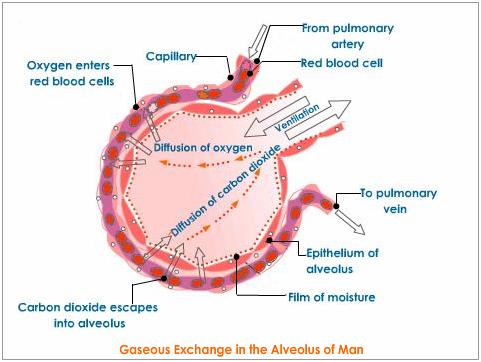| |
Gas exchange
Page history
last edited
by Darrell Sharp 12 years, 1 month ago
|
6.4 Gas exchange
Ventilation Lab
Resources:
Textbook pp104-106
Click4Biology
Gas Exchange Quiz
|

http://www.daviddarling.info/encyclopedia/A/alveolus.html
|
|
6.4.1 Distinguish between ventilation, gas exchange and cell respiration.
|
ventilation: the movement of air in and out of the lungs (breathing).
- inspiration or inhalation: gases moving into the lungs
- expiration or exhalation: gases moving out from the lungs
- the lungs do not have muscle tissue - the diaphragm and muscles between the ribs move the chest to expand and contract the lungs.
gas exchange: diffusion of gases across a membrane
- oxygen moves from the air into the blood
- carbon dioxide moves from the blood to the air
- oxygen moves from the blood to cells
- carbon dioxide moves from cells to the blood
cell respiration: releasing energy from organic compounds within a cell
- aerobic: uses oxygen and produces carbon dioxide
- anaerobic: does not use oxygen but produces carbon dioxide
(the word respiration is also used to describe breathing, so it causes confusion)
|
|
6.4.2 Explain the need for a ventilation system.
A ventilation system is needed to maintain high concentration gradients in the alveoli.
|
The ventilation system maintains the concentration gradients necessary for gas exchange.
As oxygen diffuses from the lungs into the blood, the concentration in the lungs becomes lower.
The ventilation system replaces this air with fresh air that has a higher concentration of oxygen.
Thus it maintains the concentration gradient between the air in lungs and the blood.
As carbon dioxide diffuses from the blood into the lungs, the ventilation system moves the carbon dioxide away to keep the lung concentration low.
Thus maintaining the concentration gradient for effective diffusion.
|
|
6.4.3 Describe the features of alveoli that adapt them to gas exchange.
This should include a large total surface area, a wall consisting of a single layer of flattened cells, a film of moisture and a dense network of capillaries.

http://www.britannica.com/EBchecked/media/107200/The-alveoli-and-capillaries-in-the-lungs-exchange-oxygen-for
|
Alveolus (plural: alveoli): the numerous small sacs of the lungs where gas exchange occurs.
Features of Alveoli that help gas exchange
The spherical shape of an alveolus increases the surface area for gas exchange.
- "Together, the millions of alveoli of the lungs form a surface of more than 100 square meters."
The alveoli have one cell thick walls with flat cells, so diffusion is efficient.
The walls produce a layer of moisture to help diffusion.
There is a dense network of capillaries surrounding the wall to aid gas exchange.

http://mariemakings.blogspot.com/2010_05_01_archive.html
|
|
6.4.4 Draw and label a diagram of the ventilation system, including trachea, lungs, bronchi, bronchioles and alveoli.
*Students should draw the alveoli in an inset diagram at a higher magnification.
|
see the diagram at the top of the page
<--Note: like in the above diagram
|
|
6.4.5 Explain the mechanism of ventilation of the lungs in terms of volume and pressure changes caused by the internal and external intercostal muscles, the diaphragm and abdominal muscles.
|
Muscles
Diaphragm: muscle below the lungs
Intercostal muscles: muscles between the rib bones.
Abdominal muscles: muscles of the lower torso.

http://concept2.co.uk/training/breathing
| |
Diaphragm |
External Intercostals |
Internal Intercostals |
Abdominals |
|
Inspiration
(breathe in)
|
contracts |
contract |
relax |
relax |
|
Result
|
bottom of lungs pulled down; top of lungs pulled up/out - expansion |
|
Expiration
(breathe out)
|
relaxes |
relax |
contract |
contract |
|
Result
|
bottom of lungs pushed up; top of lungs pulled down/in - contraction |

Physics
During inspiration, the lungs expand. This increases the volume inside the lungs, which decreases the air pressure inside the lungs. The air pressure outside the body is greater and pushes air into the lungs.
During expiration, the lungs contract. This decreases the volume inside the lungs and increases the pressure. The air pressure outside the body is lower, and air moves out of the lungs.
Boyle's Law (you don't need to know this)
P1 V1 = P2 V2 Pressure and volume are inversely proportional.
|
Human Biology Home
Gas exchange
|
|
Tip: To turn text into a link, highlight the text, then click on a page or file from the list above.
|
|
|
Comments (0)
You don't have permission to comment on this page.